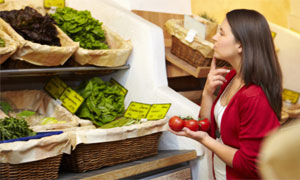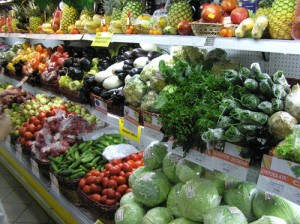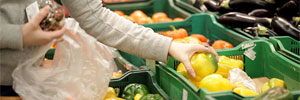Choosing the various types of vegetables
Vegetables are from living plants that grow in cycles with the passing seasons. Thus, the season of the year is the most important consideration when selecting vegetables. Not all vegetables are in season at the same time, and they need to be picked accordingly to maximize quality. Selecting an out-of-season tomato that lacks color and flavor ultimately affects the quality of the resulting meal.
The amount to buy depends on the type of vegetable being purchased. Vegetables, especially leafy ones, tend to lose volume when trimmed and/or cooked, so consumers often purchase slightly more per person to make up for the anticipated waste. Specific tips on selection are discussed for each of the vegetables in alphabetical order below.
 Artichoke
Artichoke
An artichoke is the immature flower head of a thistle. The edible “leaves” are actually petals. The most common variety is Green Globe. Selection varies according to season, with the best-flavored artichokes available in the winter when the artichokes are heavy, compact, plump, and have bronze-tipped leaves (winter-kissed) from a light frost. Spring artichokes are globe-shaped, green, and have tight leaves. The shape becomes conical in the summer and fall with the leaves becoming lighter in color and weight. Over mature artichokes are detected by leaves that separate and a woody texture. The edible portion of the artichoke includes the stem, the base (or heart), and the thicker bottom section of the leaves. The furry center, known as the choke, must be removed before consumption. Occasionally baby artichokes are sold; they are tender throughout and may be eaten whole. Mature artichokes are usually trimmed prior to preparation.
Asparagus
Tenderness is the key consideration when selecting asparagus. Tight, compact buds and fresh, firm stalks that break with a crisp snap are desired. Opened buds and flattened or angular stalks are signs of tougher, less sweet asparagus. The size and thickness of the stalk or spear is not related to tenderness. The two main types of asparagus available in North America are the more popular dark green and the less often purchased white or light green.
Beans (Green snap, green, wax, and yellow wax-podded beans)
Green (green snap beans) and yellow (wax) are the two most common types of beans. Select sturdy, crisp pods with no sign of wrinkling, pitting, or bulging in the skin due to over-maturity.
Beets
Select beets that are smooth, firm, and free of any sign of dryness. Leaves should be fresh, tender, and clean.
 Broccoli
Broccoli
In fresh broccoli, the bud clusters should be firmly closed and the head dark green to purple in color. Stems should be light green and not pale, woody, hard, or dry. The signs of decay in broccoli are subtle, but avoid broccoli with florets that are starting to open or have an uneven, yellow-green color. Calabrese is the most common variety, but others include Emperor, Premium, Futura, Green Duke, Harvester, Atlantic, Topper 430, Gem, Medium Late 423, and Medium Late 145.
Brussels Sprouts
Brussels sprouts varieties such as Citadel, Lunet, Rampart, and Valiant differ in their bud-bearing characteristics. Select those with compact leaves and clean stalk ends. Brussels sprouts with wilted, yellowish, puffy, or soft leaves are poorer in texture and flavor.
Cabbage
Look for cabbage with leaves firmly attached to the stem. The stem should be solid, hard, and heavy in relation to the head. The cabbage surface is usually smooth (except savoy cabbage), evenly colored, and free from any signs of dehydration. The most common variety is domestic cabbage, but others include Danish, the yellow-colored savoy, and red cabbage. Bok choy is Chinese mustard cabbage; it has large, sturdy, white stems and leaves, and a unique, mild flavor that enhances salads, stir-fry dishes, or soups.
Carrots
The darker the orange color, the more beta-carotene the carrot contains. The surfaces should be smooth, firm, and free from cracks, and the tops should be free from any sprouting green shoots, which would indicate an older carrot. Most carrots are sold by length and range from 2 to 8 inches long. Pre-peeled carrots are also available.
Cauliflower
Cauliflower, like broccoli, is a head of flowers. A fresh cauliflower head will not have started to bloom, spread, or look “ricey.” The color ranges from white to creamy white. Lime-green is the color of broccoflower, a hybrid between broccoli and cauliflower. The jacket leaves at the cauliflower’s base should be green and crisp. Popular varieties include Early Snowball, Super Snowball, Snowdrift, Pearl, Danish Giant, and Veitch Autumn Giant.
 Celery
Celery
The first thing to check for in celery is clean, smooth, tender-looking inner stalks. They should snap when broken and have a straight, solid cone in the center. Celery with signs of stringiness or roughness may be tough and should not be purchased. The leaves on top should be fresh, green, and free from signs of dehydration (wilting, color changes) or decay. The green variety is the most popular, although Pascal, a lighter color variety, is growing in popularity because of its special flavor and lack of stringiness and toughness.
Corn
Corn on the cob is relatively easy to select, because the husks, the stem ends, the silk strands on top, and the kernels can all be checked for freshness. Healthy husks and stems are a vibrant green and show no signs of discoloration or drying out. The stem ends are moist and not wilted or decayed. Many stores prefer that shoppers not rip open corn ears, because it causes the kernels to dry out and degrade, but when it is possible, the husk should resist being pulled back and the kernels should be plump, even sized, and ripe-colored. Any indentations in the kernels or large or dark-yellow kernels indicate older, tougher, less flavorful corn. There are more than 200 varieties of corn, but the major type found commercially is Yellow Hybrid Sweet Corn.
Cucumbers
The three types of cucumbers that are available include slicing or table, pickling, and greenhouse. Slicing cucumbers are found in most supermarkets and are best selected based on their firmness and fairly straight-sided oblong shape. The skin should be free from any soft spots or shriveling, and evenly colored, with no yellow evident. Typical supermarket varieties are heavily waxed to protect the fruit. Varieties include Ashley, Cherokee 7, Gemini, Hybrid Ashley, High Mark II, Long Market, Marketer, Palomar, Poinsett, and Straight Eight. Hothouse or greenhouse cucumbers are elongated, seedless cucumbers with a mild flavor and no bitterness. European cucumbers are long and slender and usually come wrapped in plastic. Small- to medium-sized cucumbers are utilized to manufacture pickles.
Eggplant
Freshness in eggplants is judged by the condition of the skin. It should be smooth, firm, and glossy, with a deep purple, almost black color. Eggplants are also available in white and striped varieties, and, in these, any sign of yellow indicates aging. Flabbiness, softness, or dark bruise-like discoloration indicate poor quality. Select the heaviest eggplant with at least a 3- to 6-inch diameter. Chinese eggplants have a thinner skin and are long and thin, averaging 1 or 2 inches in diameter. American varieties include Black Beauty, Florida High Market, Florida Market, Myers Market, New Hampshire, and New York Purple.
Garlic
Roman gladiators ate garlic, believing it would make them stronger and capable of great feats, and even today many people believe it has curative powers against a host of ailments. Garlic is sold in whole heads. Select firm, well-filled cloves with skins that are not overly dry. Avoid those that are sprouting or have dark or rotted areas. Garlic can be peeled and minced by using a garlic press, or the clove can be crushed on a cutting board under the side of a chef’s knife or heavy object such as the side of a can. Garlic ranges in color from white to dark maroon, and varieties include Argentina White, California Early, California Late, Mexican Purple, and Mexican White. Elephant garlic, which is much larger, milder, and sweeter than regular garlic, is gaining in popularity, and is capable of reaching 6 inches in diameter and weighing up to 12 ounces.
Ginger Root
This vegetable, often used as a spice in Asian, Indian, Moroccan, and Caribbean dishes, is selected by looking for a smooth, non-wrinkled skin with a fresh sheen and filled-out flesh. Choose ginger root that breaks cleanly with a snap and has the least number of knots.
Greens
Greens are leafy vegetables that include collards, dandelion, kale, mustard greens, beet greens, endive, and Swiss chard. These excellent sources of vitamin A should be fresh, crisp, tender, and free from any drying, insect damage, or decay. Top varieties for each of the greens are as follows:
- Collards. Georgia, Louisiana Sweet, Morris Heading, and Vates
- Dandelion. Arlington Thick Leaf, Improved Thick Leaf, and Thick Leaf
- Kale. Dwarf Blue Curled Scotch, Dwarf Green Curled Scotch, and Tall Green Curled Scotch
- Mustard greens. Florida Broad Leaf, Large Smooth Leaf, Fordhook Fancy, Southern Giant Curled, and Tendergreen
- Swiss chard. Burpee’s Rhubarb Chard, Dark Green White Ribbed, Fordhook Giant, Giant Lucullus, and Rhubarb Chard
Leeks
This mild-flavored member of the onion family is traditionally used in soups and French dishes. Select leeks with tender leaves that are not too fibrous or coarse. Varieties include American Flag (London Flag), Blue Leaf, Carentan (Winter), and Musselburg.
Lettuce
Lettuces are leafy vegetables that serve as the foundation for salads and as an ingredient in sandwiches or tacos. Select lettuce with fresh, crispy leaves and no signs of withering or dehydration. Iceberg lettuce can be easily cored by holding the head core down and rapping it against the counter. This motion forces the core into the head, and it can then be easily twisted and removed. The lettuce head is then rinsed core-up so that the cold running water will spread through the leaves. All moisture should be removed after lettuce is washed to slow decay.
Mushrooms
Mushrooms are actually a type of fungus that lacks chlorophyll. Select mushrooms with firm, smooth caps that are free of slime, mold, wilting, or bruises. The appearance of gills underneath the umbrella can indicate aging, although they are always visible in some varieties. If present, the gills should be clean, not too dark, and unbroken. Once purchased, mushrooms are often not washed, but instead stemmed and cleaned with a damp cloth or paper towel or scraped clean with a paring knife. They are very absorbent, so exposing them to water may ruin their flavor and texture, although many individuals subject them to a quick rinse just prior to preparation. There are quite a few varieties of mushrooms from which to select. “Wild” mushrooms should not be picked from fields, forests, or any other location, because even mushroom identification experts have been reported to make mistakes and get extremely ill.
Okra
Okra consists of edible pods filled with seeds. The pods should be young and tender, and range from 1 to 3 inches in length. Fresh pods snap and puncture easily, while older ones are dry, fibrous, have a dull color, and contain hard seeds. Okra pods are usually green, but white and purple varieties are also available. Popular varieties of okra include Clemson Spineless, Dwarf Long Pod, French Market, and Perkins Spineless.
Peas
The three pre-dominating varieties of peas are green, snow, and sugar snap. Green peas have a bulging pod, snow pea pods are flat, and sugar snap pod diameters range somewhere between green and snow peas. Unlike green peas, snow and sugar snap peas are consumed with their pods. All should be fresh, tender, and sweet. Avoid those that are in an advanced stage of maturity, which is signaled by grayish specks, yellow streaks, a darker color, dryness, and wrinkling.
Peppers, Sweet
Sweet peppers are available in many colors – green, red, yellow, orange. purple, and brown. As peppers ripen. they become sweeter because of their increasing sugar content. Those with a bright, smooth, glossy color and thick, filled-out walls and a good solid weight are recommended, while those that are pitted, dull-looking, or shriveled should be avoided. Bell peppers with a more square or rectangular shape are easier to cut up. California Wonder is the most common variety of pepper, and ethers include Early Cal-Wonder, Burlington, Chinese Giant, Harris Early Giant, Neapolitan, and Yolo Wonder. Other sweet peppers include the round cherry, pimento, Holland, sweet Hungarian, Cubanelles, Italian, bull horn. and sweet banana wax.
Peppers, Hot (Chili)
Chili peppers come in a variety of colors, shapes, and degrees of ‘heat.’ Green, red, yellow, and black are the predominant colors. The skins of fresh chilis should always be bright, shiny, firm, and unwrinkled. Several of the more common types of chili peppers (Mexican varieties) include jalapeno, Anaheim, yellow chile, chile de arbol, ancho, pasilla, serrano, and habefiero, which is the hottest of all hot peppers.
Radishes
Radishes are classified by shape: globular, oval, turnip-shaped, oblong, and long. The Red Globe type is the most popular and is selected based on a bright red color, smooth, firm skin, healthy roots, and crisp, white flesh. Avoid those that are cracked open, withered, spongy, and dry or rough looking. The leaves should be fresh and vibrant with no signs of decay. The daikon is a white, sweet, and elongated radish from Asia that is shaped like a carrot. Some markets also sell the large black radish, which is black on the outside and white on the inside.
Rutabagas
Looking much like a turnip, rutabagas are more purple/beige in color, have a yellowish flesh, and have leaves that are thicker and smoother. The three most common varieties are American Purple Top, Laurentian, and the Thomson Strain of Laurentian. Like cucumbers, rutabagas are often sold heavily waxed.
Spinach
Fresh, dark green spinach leaves with good turgor are preferred over those that are wilted, decaying, straggly slimy, or have large, rough stalks. Varieties include dark green Bloomsdale, Bloomsdale Long Standing, Old Dominion, and Virginia Savoy Spinach leaves may be wrinkled (savoy), flat, or semi-savoy, which is a combination of wrinkled and flat (sold for fresh and processed purposes). Young, tender leaves are somewhat lighter green and best used for salads, while the darker, more mature leaves are preferred for cooked preparations.
Sprouts
The two dominant types of sprouts on the market are alfalfa and mung bean. The greenish-topped, white-stemmed alfalfa sprouts are selected based on very little breakage of the stems and freedom from wilting or slime. The sprout heads should be full, vibrantly green, and provide an overall nut-like flavor. Bean sprouts grown from mung beans are long, ivory-colored strands of uniform length and with a crisp, snappy texture. Other sprouts. including radish, are also often available.
Squash
There are two categories of squash: Summer or soft-skinned types and winter or hard-shell types.
Summer Squash. Summer squash include zucchini, yellow crookneck, yellow straightneck, chayote, cucuzza, scallopini, and sunburst. Look for small squash with a shiny skin and no bruises or scars. The smaller the squash, the more tender its flesh, seeds, and skin. Pits in the skin are caused by chilling, while dull skin or discoloration may indicate old age.
Winter Squash. It is difficult to determine the eating quality of winter squash because of their hard outer rind. Examples of winter squash include acorn, butternut, pumpkin, spaghetti, banana, turban, hubbard, delicata, sweet dumpling, kabocha, and golden nugget. Select those that are dull and heavy for their size; as winter squash age, they become lighter in weight, indicating a dry and stringy texture. When selecting a pumpkin, look for a clean, untracked surface with a bright orange color. Avoid those that show scarring, excess wrinkling, fading color, or soft spots on the rind.
Tomatoes
Tomatoes are often sold unripe because they are easily bruised during transportation. The color changes from green to bright red or reddish-orange as tomatoes ripen. Once ripe, they should give to gentle palm pressure; a watery consistency or slippery skin is a sign of being overly ripe. A sweet delicate aroma often accompanies ripeness. Sometimes cutting the tomato open is the only way to determine if it is ripe for consumption.
The most common types of tomatoes are: mature green, which are best for slicing or garnishes; vine-pink/vineripe, suited for stuffed tomato entrees or salad wedges; romas, which are elongated in shape, meaty, and flavorful, making them ideal for salads and sauces; and cherry tomatoes, ranging from the size of marbles up to ping-pong-ball size, which are excellent for salads, garnishes, or salad bars. These tomatoes soften at a slower rate than other tomatoes, allowing them to be harvested at a later date after they have had more time to ripen.
Turnips
Soups and stews are the main dishes to which turnips are added. A firm, well-rounded turnip, free from shriveling or rough skin, is preferred. Common varieties include Amber, Golden Ball, Purple Top, Yellow Aberdeen, White Egg, and White Globe.
